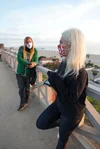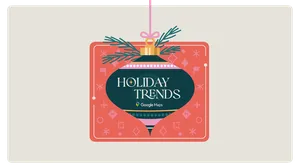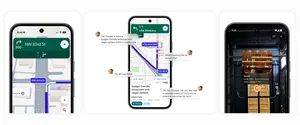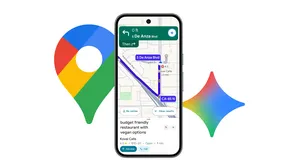A Local Guide uses Google Maps to help those without homes

When Ashley Sundquist moved to Santa Monica, California four years ago, she noticed something different from the other places she’d lived. “I’ve lived in big cities much of my adult life; I’ve lived in Washington, D.C., Rome and New York City,” she says, “and none of those places prepared me for how many people here in Santa Monica are unhoused.” Santa Monica is part of the greater Los Angeles area, and according to city statistics, 907 people experience homelessness on any given night in the city; if you widen the area to include all of L.A., that number skyrockets to approximately 66,000.
During her morning commute, Ashley noticed how many people were living outside and gathering at the Santa Monica Public Library. Her gym was next door, and eventually, Ashley started crossing the street to say hello. Soon, she’d made connections with library employees and the people without homes who gathered there, and she began looking for ways to help.
She also became friends with a man named Joe, an unhoused member of the community who was often at the library. Joe mentioned he struggled with getting lost, which inspired her to turn to Google Maps and the app’s list feature. You can use this to create a list of places, like your favorite restaurants or places you want to visit on vacation. As an active member of the Local Guides program, a global community of contributors on Google Maps, Ashley was no stranger to sharing helpful information about her community with others.
So Ashley started creating lists for people in need. She made lists of resources for young people experiencing homelessness, food banks and restaurants that accept EBT cards. To make things even easier to find, Ashley bought the domains “lashelters.org” and “lashelters.com,” which send visitors to these lists. “Now when anybody in the world goes to one of those websites, they’ll see these maps,” Ashley says. Joe and Ashley also became friends, and he helped get the word out about the websites.
Ashley’s Google Maps list for youth resources in L.A.

When the COVID-19 crisis hit, Ashley had to pivot. Right away she volunteered her time to teach caseworkers (via Google Meet) how to create their own lists in Google Maps. “I walked them through step-by-step how to search for locations, update the description and share the URL,” she says. She also created a list to help people find free Wi-Fi after many restaurants, coffee shops and other places that offer internet access closed their doors, and another list to help people find transportation to shelters when COVID-19 precautions altered bus schedules.
Still, things changed so dramatically so quickly; she wanted to do more. “Toward the end of last March, I realized things weren’t going to go back to the way they were anytime soon. I knew how our outreach efforts were going to have to be different.” She started consulting with local agencies to gather information for more lists, or update the ones she’d already made with new COVID-19-related restrictions, changing hours or other stipulations.
Eventually she wanted to try getting the information she’d gathered out in person. In May, she started volunteering at a weekly dinner serving some 150 unhoused neighbors at her local Salvation Army. Soon, she began leading dinners and helped her church get more involved. “We have 20 or so volunteers, with masks, temperature checks, distanced, all of that,” she says. “It’s a huge undertaking but I feel like it gives me a captive audience. Our team can bring a little light and love into a very dark place. We can help people find local resources on the Google Maps lists.”
Ashley greets everyone as they wait in line for their meal and makes an effort to learn names. “It might be the only time someone speaks to them or uses their name that week,” she explains. “I really work to build a rapport so then I can say to them, ‘Oh I see you’re having trouble getting this or finding that.’” Then she takes out her phone and shares her Google Maps lists on the spot. Ashely notes that many people without homes have smartphones, which act as their lifelines, but if she’s speaking with someone without one, Ashley uses her own to access her lists to call and try to help get them what they need — whether it’s a spot at a shelter or a no-cost doctor appointment.
“People are dealing with homelessness, trauma, hunger, mental health issues, technology barriers...I feel like the least I can do is make the available resources easier to find with a Google Maps list,” she says.
Ashley’s hope is that her neighbors feel seen and cared for, and that the Google Maps lists help them meet their basic needs. “I don’t think people realize how tremendously difficult it is to get help when you’re experiencing homelessness,” she says. “I hope this can help people get through their day with dignity and humanity. That’s what we’re all trying to do right now.”
Ashley looks through Google Maps lists with her friend Joe, whom she met through her work with unhoused people. Joe is also an advocate for his community.








